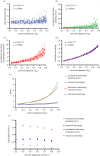Elucidating the signal for contact guidance contained in aligned fibrils with a microstructural-mechanical model
- PMID: 35582810
- PMCID: PMC9114932
- DOI: 10.1098/rsif.2021.0951
Elucidating the signal for contact guidance contained in aligned fibrils with a microstructural-mechanical model
Abstract
Despite its importance in physiological processes and tissue engineering, the mechanism underlying cell contact guidance in an aligned fibrillar network has defied elucidation due to multiple interdependent signals that such a network presents to cells, namely, anisotropy of adhesion, porosity and mechanical behaviour. A microstructural-mechanical model of fibril networks was used to assess the relative magnitudes of these competing signals in networks of varied alignment strength based on idealized cylindrical pseudopods projected into the aligned and orthogonal directions and computing the anisotropy of metrics chosen for adhesion, porosity and mechanical behaviour: cylinder-fibre contact area for adhesion, persistence length of pores for porosity and total force to displace fibres from the cylindrical volume as well as network stiffness experienced upon cylinder retraction for mechanical behaviour. The signals related to mechanical anisotropy are substantially higher than adhesion and porosity anisotropy, especially at stronger network alignments, although their signal to noise (S/N) values are substantially lower. The former finding is consistent with a recent report that fibroblasts can sense fibril alignment via anisotropy of network mechanical resistance, and the model reveals this can be due to either mechanical resistance to pseudopod protrusion or retraction given their signal and S/N values are similar.
Keywords: aligned fibril networks; cell–matrix interaction; contact guidance.
Conflict of interest statement
We declare we have no competing interests.
Figures




Similar articles
-
Cell contact guidance via sensing anisotropy of network mechanical resistance.Proc Natl Acad Sci U S A. 2021 Jul 20;118(29):e2024942118. doi: 10.1073/pnas.2024942118. Proc Natl Acad Sci U S A. 2021. PMID: 34266950 Free PMC article.
-
Transfer of assembled collagen fibrils to flexible substrates for mechanically tunable contact guidance cues.Integr Biol (Camb). 2018 Nov 12;10(11):705-718. doi: 10.1039/c8ib00127h. Integr Biol (Camb). 2018. PMID: 30320857 Free PMC article.
-
Fabrication of dense anisotropic collagen scaffolds using biaxial compression.Acta Biomater. 2018 Jan;65:76-87. doi: 10.1016/j.actbio.2017.11.017. Epub 2017 Nov 8. Acta Biomater. 2018. PMID: 29128533 Free PMC article.
-
Multifarious Fabrication Approaches of Producing Aligned Collagen Scaffolds for Tissue Engineering Applications.ACS Biomater Sci Eng. 2020 Feb 10;6(2):779-797. doi: 10.1021/acsbiomaterials.9b01225. Epub 2020 Jan 14. ACS Biomater Sci Eng. 2020. PMID: 33464865 Review.
-
Collagenous Extracellular Matrix Biomaterials for Tissue Engineering: Lessons from the Common Sea Urchin Tissue.Int J Mol Sci. 2017 Apr 25;18(5):901. doi: 10.3390/ijms18050901. Int J Mol Sci. 2017. PMID: 28441344 Free PMC article. Review.
Cited by
-
Computational and Experimental Characterization of Aligned Collagen across Varied Crosslinking Degrees.Micromachines (Basel). 2024 Jun 29;15(7):851. doi: 10.3390/mi15070851. Micromachines (Basel). 2024. PMID: 39064362 Free PMC article.
-
Topographical cues of biomaterials and fibroblast activation: Are they related?Mechanobiol Med. 2023 Oct 31;2(1):100028. doi: 10.1016/j.mbm.2023.100028. eCollection 2024 Mar. Mechanobiol Med. 2023. PMID: 40458549 Free PMC article. Review.
References
-
- Tocce EJ, Liliensiek SJ, Broderick AH, Jiang Y, Murphy KC, Murphy CJ, Lynn DM, Nealey PF. 2013. The influence of biomimetic topographical features and the extracellular matrix peptide RGD on human corneal epithelial contact guidance. Acta Biomater. 9, 5040-5051. (10.1016/j.actbio.2012.10.007) - DOI - PMC - PubMed
Publication types
MeSH terms
Grants and funding
LinkOut - more resources
Full Text Sources

